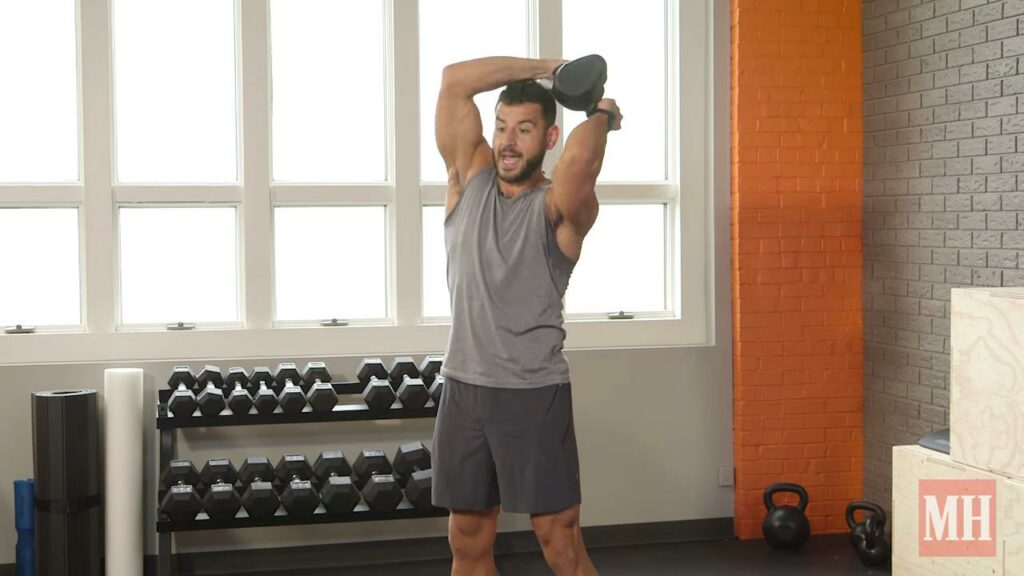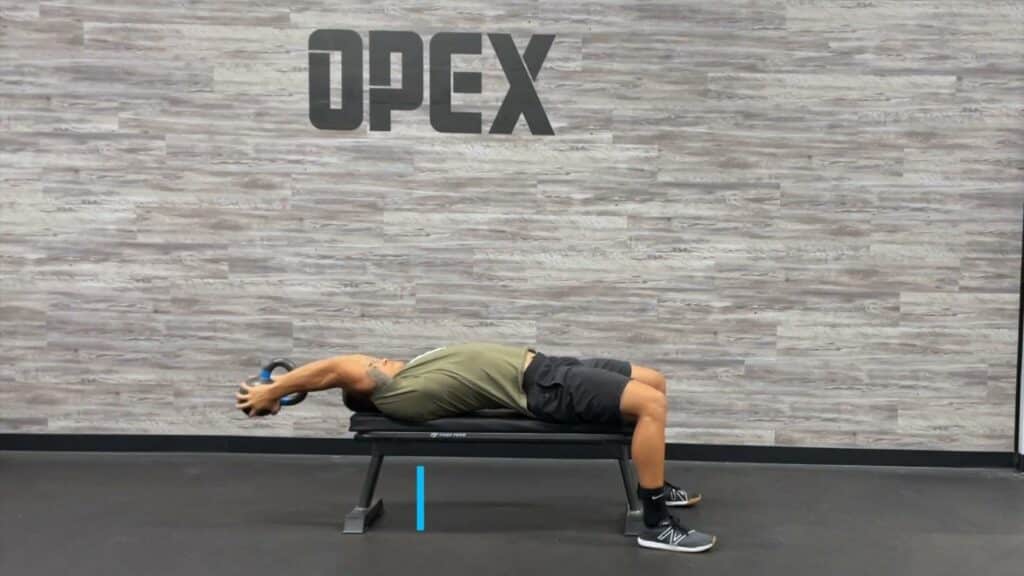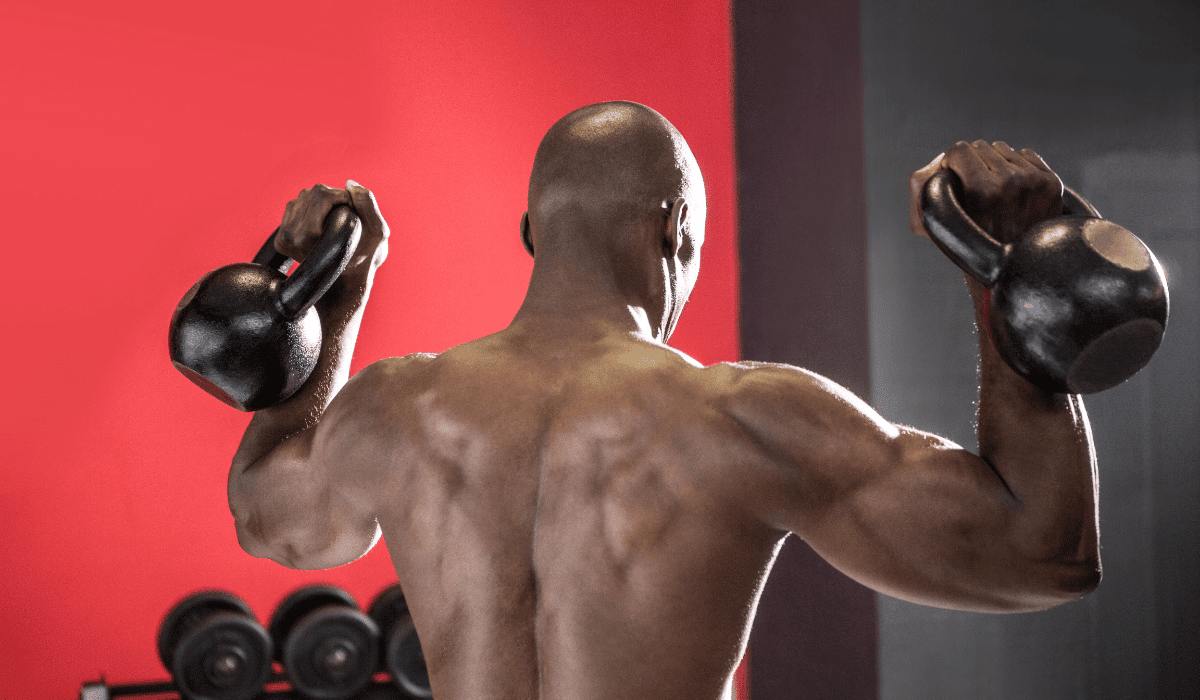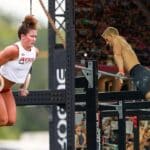Are you ready to transform your back with the power of kettlebells? Dive into our expert guide and discover 15 dynamic back exercises that promise to enhance your strength, coordination, and power.
Whether you’re a gym novice or a seasoned athlete, these kettlebell workouts are designed to challenge your muscles in new ways, ensuring balanced development and a rock-solid posterior. Unlock the secrets to a stronger, more resilient back and reap the benefits of improved posture and explosive power.
Don’t miss out on the chance to revolutionize your fitness routine—read on to learn how these kettlebell exercises can elevate your training to the next level.
Jump to:
Anatomy of Your Back Muscles
Before we get into the best training techniques for the back, let’s cover some basic anatomy.
First, for our purposes, we’re going to split the back into four key muscles:
- Latissimus dorsi (lats);
- Trapezius (traps);
- Rhomboids;
- The erector spinae or spinal erectors.

The Lats
The lats contribute mostly to the appearance of the back width. They have two key functions:
- to adduct the arm or basically bring the arm in closer to the body when it’s out to the side;
- and to extend the arm or basically bring the arm in closer to the body when it’s out in front.
If we want to hit the lats, we should be performing exercises that train shoulder extension and shoulder adduction.
The Traps
The traps contribute mostly to the appearance of back thickness. While their individual functions are highly varied, the upper traps’ main function is to elevate the scapula like in a shrug. While the mid and lower traps primarily retract the scapula like in a row.
The Rhomboids
The rhomboids are split into a rhomboid major and a rhomboid minor. But both have the same main function which is scapular attraction. So for the most part these muscles will be targeted with the same basic exercises that hit the mid-traps.
The Erector Spinae
The spinal erectors of the lower back extend all the way up the spine to the skull and function to extend the entire vertebral column. Also, strong erector spinae muscles prevent back pain.
15 Back Exercises With Kettlebells
We’re going to be focusing on kettlebells for improving back. These exercises are perfect for both fitness levels beginners and professionals. And all you need are two kettlebells. And we’re going to be using a chair to help with some of the movements. Let’s get started.
If you are a beginner or a woman, move through 5-6 exercises, 10 reps of every exercise (with a 6-kg kettlebell light weight).
If you are a man, perform 10 exercises with an 8-kg kettlebell weight. Be sure to do 10 reps of every exercise. Your back muscles will burn tomorrow! Make sure you get a good stretch in.
If you are a professional athlete, perform all 15 exercises (12-15 reps) with a 10-kg or 16-kg kettlebell weight. Good luck!
Whole Back Kettlebell Exercises
Here are our exercises for your whole back muscles.
1. Assisted Single-Arm Bent Over Row
For the first exercise, we’re going to be doing an assisted single-arm bent-over row. You need one kettlebell and you don’t need to go super heavy kettlebells.
You’re going to place one hand on the chair. Make sure that your hips are not too far backward or you’re leaning too far forwards. You want the wrist to be stacked right underneath your shoulder. Keep your back flat. If you’re having a hard time and your back is rounding out, remember you’ve got to engage your core by tightening up your lower back.
So, feet hip-width apart. And you’re going to lift the kettlebell up. As if you’re trying to tuck it into the pocket of your armpit. After performing 12 reps, do the other side switching hands.
2. Bent Over Tricep Kickback
For the second exercise, we’re going to be doing a bent-over tricep kickback. You can also support your body weight with the use of your chair. You can have a staggered stance if you’d like. Holding onto your weight start with your arm bent and your kettlebell towards your chest. You’re going to kick your arm back simply extending your hand all the way out as if you’re trying to touch the back wall.
Switch your hand on the chair for your support. Bring the kettlebell up to your chest and then start kicking back.
If one side feels harder than the other, that’s the whole reason behind unilateral movement so that you can strengthen both sides. Remember you want to keep your elbow up the whole time. If your elbow starts to sink, just reset yourself.
3. Bicep Curl + ISO Hold
On our third exercise, we’re going to be doing a standing single-arm bicep curl and the other arm is going to be doing an ISO hold. So it’s going to burn a little bit.
Grab onto both kettlebells standing comfortably with your feet hip-width apart. You’re going to decide which side you’re going to start on. Hold your bicep curl at a 90-degree angle on one side and do 12 bicep curls with the other hand all the way up and all the way down. If you feel like you’re starting to lose that ISO hold, reset. Switch your arms.
4. Renegade Row
Onto our last exercise, it’s the renegade row. You need one kettlebell. Starting in your plank position, you want to make sure that your wrists are stacked right underneath your shoulders. If you’re going to be doing bodyweight, you’re going to be lifting up your hands close to your shoulder as if you’re pulling a weight up into your armpit.
Once you feel comfortable, start with one side of your renegade row. So stay stable on your right hand. You’re going to be lifting up the kettlebell into your armpit for a renegade row. What you want to avoid is letting your hips twist open. That means your core muscles are starting to disengage. Once it starts to happen, reset yourself. Bring it down to your knee and then come up again to start.
If you’re using two kettlebells and you have your wrists stacked over, you’re definitely more likely to sprain your wrist or injure yourself. So stick to one. Keep it safe.
Start with the other side in your plank position. Test what it feels like without the weight. Once you feel ready, grab your weight.
5. Double Kettlebell Swing
Flex and extend the hips. With a neutral grib, keep the kettlebell moving it to an eye-level position. Make sure you get the knees out of the way.
Upper Back Kettlebell Exercises
6. Kettlebell Halo

Start in a standing position. Feet hip-width apart. With a neutral grip, grab the kettlebell with both your hands and hold it at your chest level. Keep your elbows bent. This is going to cause better tension in your back muscles and it’s going to prevent any excess load on the lower spine.
Then we’re going to lift it right up off the ground. So take a big inhale and then exhale as you stand up. And then pop your hips forward.
If you want to go lighter, you’re more than welcome to. Especially, if it will help your form be better and stronger.
7. Pullover

This exercise works the upper back muscles. Start lying on your back, grab a kettlebell with a neutral grip. And lift it above your head. Then lower the kettlebell behind you. Take a big inhale down, exhale up. This exercise require good core strength.
8. Kettlebell Reverse Lunges
Using an overhand grip, row coming to the front alternating two times row.
A big mistake is jerking the weight and that means it’s way too heavy. So if you have to jerk up the weight to get it up into that pocket, then you should probably think about lowering the weight a little bit. It’s better to do form first above heavy weights.
9. Ketlebell bob and leave
Kettlebell Bob and Leave is a great way to work out the back muscles. It involves holding a kettlebell in one hand while performing a squatting motion with the other. The squatting motion helps to strengthen the lower back, while the kettlebell adds resistance for an extra challenge. This exercise can be done anywhere, making it perfect for those who are short on time or don’t
10. Half Burpee Single Arm Deadlift
For the next one, get up in one line with your feet. You need a single kettlebell. We’re going to be starting with half burpees and switching to one arm deadlift. Keep a stable position.
11. Landmine Row
Keeping the flat back, hinge forward from the hip. Bend in the knees a little bit. Draw your elbows back with an explosive movement.
Lower Back Kettlebell Exercises
12. Two-handed Kettlebell High Pull
Make sure the hip hinge is back on your heels first. You need a single kettlebell. Reach a kettlebell with two hands using a neutral grip. Begin with a big back swinging back between your hips. Your elbows have to drive up.
13. Deadlifts
At the starting position, feet shoulder-width apart. Toes are parallel to each other. You need a single kettlebell. We want to push our hips backward which is called a hip hinge. Pull your shoulder blades in and backward and engage the upper part of your lats. Flow with the kettlebell movement.
14. Alternating From Bottom Row
Hands rest down by the sides. A little bend in the knees. You’re going to think about your starting point as well as the exercise itself. Keeping your spine nice you’re going to hinge forward from the hip. Take one arm back at a time. Then change to the other.
15. Goblet Walk
We’re going to straddle the weight and pull it straight up the body’s line. Keep the kettlebell tight to the body. You’re going to walk forwards and then backward.
Tips to Get the Most Out of Your Kettlebell Back Workout
- Vertical and horizontal pulls aren’t the only back exercises. Exercises that force you to stabilize your spine during hinge movements and carry variations are great as well.
- Incorporating multiple row variations in both a unilateral and bilateral fashion is a great way to build more size while eliminating imbalances.
- When doing a complex of different row variations, always move from most demanding to least demanding.
- The spine stabilizing component of all hinge-based movements (including swings and deadlifts), as well as carries, is a great way to develop your entire back.
- There is no better exercise to develop size in your traps than walks with kettlebells. Add them at the end of all upper body routines.
- With both double kettlebell and double hand swings, scapular retraction plays a big role in helping to target the upper and middle back.
- The circuit flows from pulls to ballistic hinges to hingers to carry’s in a most to least demanding nature.
- The most seamless and sensible way to end any workout when size, strength, and conditioning are the goal is to carry a kettlebell.
- Not only are they an easy way to extend any set for more stress placed on your back as well as strong core muscles, but also help further elevate your metabolism for more fat-loss too.
Benefits of Back Exercises With Kettlebell
Here are six benefits that you can expect to see by doing consistent these back exercises with kettlebells.
1. Full-body Strength
Part of the magic of kettlebells is that they’re not just good for your back muscles, they can also help skyrocket the strength of other muscles. They also will help you build muscle mass throughout your body.
Since most kettlebell exercises recruit muscles from head to toe, everything from swings to Turkish get-ups will make you a much stronger athlete. Kettlebell back moves tend to be either extremely slow like kettlebell windmills or fasten an explosive like the cleaning press. Both types activate muscles all over your body.
2. Coordination and Mobility
To perform back exercises with kettlebells, you’ve got to be both coordinated and mobile. You can’t perform a proper kettlebell snatch without sufficient full-body coordination. There is no way if you don’t have enough kinesthetic awareness to slip your hand into the right position above your head without slapping the kettlebell on your forearm.
You also need sufficient shoulder mobility and overhead stability to settle the weight in the top position.
The good news is that you don’t have to start performing back exercises with kettlebells with good coordination or mobility. You can start small. You can build overhead mobility, coordination, and stability with moves like Turkish getups and kettlebell windmills.
You’ll develop better back mobility and coordination through training proper kettlebell deadlifts and swings. By the time you build up to the more complex kettlebell back moves, your coordination and mobility will have grown tremendously.
3. Training Versatility
You don’t need to drag yourself to the gym at four in the morning to get a good workout. The versatility offered by kettlebell back training is a key benefit of these implements. You can literally work out anywhere with kettlebells.
The versatility offered by kettlebells means that you can train with completely different dynamic movement patterns that you might be used to. Kettlebells help you add challenges that are substantial even at sub-maximal loads. This means less stress to your body overall while stimulating growth in new areas of your strength and athleticism.
4. Fight Imbalances
Some kettlebell moves like swings require both hands on the kettlebell. But most kettlebell exercises are unilateral. This means that you either perform reps with one side at a time or have one bell in each hand so your arms work independently. This means that strength and back muscle asymmetries don’t stand much of a chance in the face of kettlebell training.
Plus if aesthetics are your goal, balancing your strength can help you equally stimulate each side of your body.
5. Power Development
Grinding out a difficult lift takes a tremendous amount of mental discipline. But moving weights quickly takes a different skill and mental toughness. Kettlebells can help you become a more powerful lifter from swings and cleans to snatches and high pulls.
Many back exercises with kettlebells require you to move the heavy weight quickly. You’ll find that the more you practice with kettlebells, the more efficient at force development you become. If you’re a powerlifter, this can help your main lifts by making your body more comfortable under stress.
6. Grip Strength
Your whole body will get stronger while working with kettlebells. Your grip strength is worth mentioning in particular. Kettlebell back training often involves timed circuits or flows during which you don’t drop the kettlebell for minutes.
Kettlebells are phenomenal for building overhand grip strength because you’re controlling the bell while it’s moving through different planes during a snatch. Your forearm will cycle through multiple angles throughout the move.
Back Exercises With Kettlebells: FAQs
How do I train my back with kettlebells?
There are plenty of options available for beginners to intermediate to advanced kettlebell users. So, grab a kettlebell next time you head into the gym or at your home gym to perform these 15 back exercises with kettlebells.
Are kettlebell workouts good for your back?
Your back gets stronger and more stable. Your entire body will get a serious boost of strength from working with kettlebells with a particular emphasis on the back. Also, kettlebell workouts provide you with cardio benefits, weight loss and the improved posture.
How do I train my lats with kettlebells?
To hit the lats most optimally, we should be performing back exercises with kettlebells that train shoulder adduction and exercises that train shoulder extension. For example, perform half-kneeling overhead press, kneeling windmill, or kettlebell halos to reach your fitness goals.














